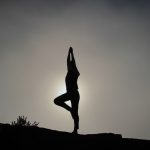Practising on the edge. For those of you old enough to remember, the Edge used to refer to the lead guitarist of U2 (Showing my age? Perhaps!), but for those of us in the yoga world, the edge means something entirely different.
Practising on the edge is a relatively recent term in yoga. It refers to advancing in our yoga practice, daring to go further than we have before. It requires courage, discipline, trust, and clarity. Practising on the edge means going further with our physical, emotional and psychological boundaries than we ever thought possible. Playing on the edge is essential to avoid stagnating on our yoga journey. Yes it’s scary, but growth comes from doing the things that scare us, and with growth, comes freedom. But what does it actually mean?
Know Your Limits; Don’t Ignore Them
In our culture of “work hard, play hard,” “go hard or go home,” or my personal favourite, “get fit or get fat” (yes, I actually saw that in a gym once), the meaning of playing the edge has been narrowed so much that it is mistakenly taken to mean “just push harder.“ In our desire to be ‘better’, we try to get somewhere before we’re ready, without cultivating our awareness of the delicate interplay between breath, consciousness and movement which is what is needed to really allow us to move deepen and go further.
One of my writers about yoga is a teacher named Erich Schiffmann, who describes the edge by saying,
The body’s edge in yoga is the place just before pain, but not pain itself.
In the first few years of our yoga practice, it’s likely that our focus should be on cultivating the breath and a wholehearted intention to focus the mind on the present moment. If your attention wanders and you’re trying to go deeper than you have before then you risk injury. Yoga is a lifelong journey. If you truly understand yourself, you will know when the time comes to intensify your practice, and this cannot be learned before you learn when to back off.
See Also: Tapas – Let The Transformation Begin
Learning to Fly
Practising on the edge can refer to the fine balance between working hard, but staying calm; of the delicate interplay with prana and apana; of the subtle energies that we are working with when we practice yoga. It’s not recommended to practise yoga unless we have both attention and intention, and it’s certainly not advised to start playing the edge without both these and a trusted teacher by your side.
A lot of playing on the edge is also about understanding our resistance. If we are afraid of hurting ourselves, looking silly or are experiencing an emotional reaction to opening the body in a new way, then we can hold ourselves back when we are actually capable of moving further forward. Practising on the edge can mean challenging our beliefs about ourselves and the world. This may be as simple as the belief that a certain asana is impossible for us, or that we are only capable of so much, but one thing’s for sure, a regular yoga practice will keep you questioning more.
Things to Remember When Practising on the Edge
1. Yoga should never cause pain
The stretch in yoga should take you to that point just before pain, the sensation you feel when you’ve stretched just a little bit further than you thought was possible. You can feel the skin stretching, you’re aware of the sensation of the muscles, perhaps even of the organs, and you’re able to sustain the posture at this point. If we are practice yoga mindfully, we should never hurt ourselves. It’s when we get competitive, daydream or do not have a strong connection with the body that we can cause pain – and yoga should never be about causing pain.
2. There’s no such thing as perfect
The idea of the perfect yoga body, the perfect posture, hell, even the perfect lifestyle is so dangerous to our yoga practice. If you’re practising yoga with your head — with thoughts and beliefs of what the asana should look like, what the alignment should be — then you can’t practice at your edge, because practising on the edge requires feeling the movement, being with the breath, and trusting the heart to know when to take you further.
Read more: Ahimsā – Why Practising Kindness Isn’t Always As Easy As It Seems
3. Use the breath
I know that when I struggle with an asana, perhaps sacrificing technique and alignment to ego and drive, I instantly lose the breath. Sirsasana, or headstand, is a classic example. In my effort to balance, my breath sometimes shortens. When we lose the breath, we are no longer practicing yoga, let alone playing the edge. If during your practice you notice the breath shortens or speeds up: back up, reassess where your energy is at, and then perhaps try again. Discernment, intelligence and clarity are vital to achieve an asana practice which is both challenging and safe.
Ultimately, as always in yoga, what we can do with the physical body is really a means to an end to taking us on our journey of self-realisation. It is when we realise that we the universe and that the universe is in it is that we have really understood what it means to play the edge.













